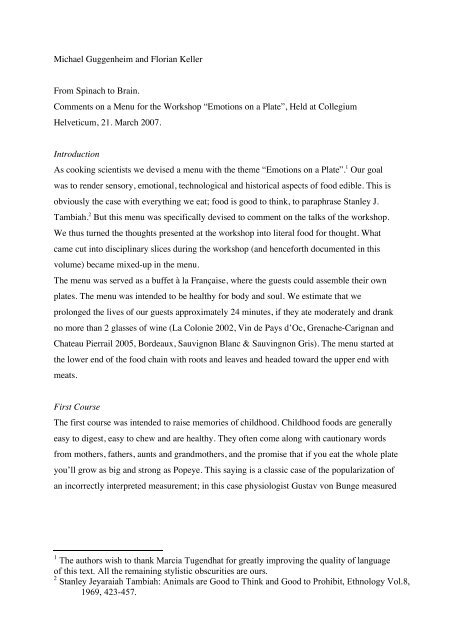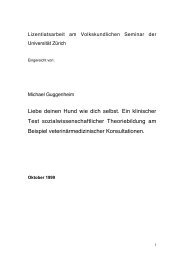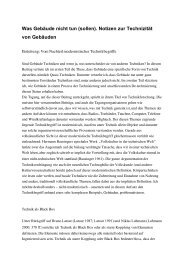Michael Guggenheim and Florian Keller From Spinach to Brain ...
Michael Guggenheim and Florian Keller From Spinach to Brain ...
Michael Guggenheim and Florian Keller From Spinach to Brain ...
Create successful ePaper yourself
Turn your PDF publications into a flip-book with our unique Google optimized e-Paper software.
<strong>Michael</strong> <strong>Guggenheim</strong> <strong>and</strong> <strong>Florian</strong> <strong>Keller</strong><br />
<strong>From</strong> <strong>Spinach</strong> <strong>to</strong> <strong>Brain</strong>.<br />
Comments on a Menu for the Workshop “Emotions on a Plate”, Held at Collegium<br />
Helveticum, 21. March 2007.<br />
Introduction<br />
As cooking scientists we devised a menu with the theme “Emotions on a Plate”. 1 Our goal<br />
was <strong>to</strong> render sensory, emotional, technological <strong>and</strong> his<strong>to</strong>rical aspects of food edible. This is<br />
obviously the case with everything we eat; food is good <strong>to</strong> think, <strong>to</strong> paraphrase Stanley J.<br />
Tambiah. 2 But this menu was specifically devised <strong>to</strong> comment on the talks of the workshop.<br />
We thus turned the thoughts presented at the workshop in<strong>to</strong> literal food for thought. What<br />
came cut in<strong>to</strong> disciplinary slices during the workshop (<strong>and</strong> henceforth documented in this<br />
volume) became mixed-up in the menu.<br />
The menu was served as a buffet à la Française, where the guests could assemble their own<br />
plates. The menu was intended <strong>to</strong> be healthy for body <strong>and</strong> soul. We estimate that we<br />
prolonged the lives of our guests approximately 24 minutes, if they ate moderately <strong>and</strong> drank<br />
no more than 2 glasses of wine (La Colonie 2002, Vin de Pays d’Oc, Grenache-Carignan <strong>and</strong><br />
Chateau Pierrail 2005, Bordeaux, Sauvignon Blanc & Sauvingnon Gris). The menu started at<br />
the lower end of the food chain with roots <strong>and</strong> leaves <strong>and</strong> headed <strong>to</strong>ward the upper end with<br />
meats.<br />
First Course<br />
The first course was intended <strong>to</strong> raise memories of childhood. Childhood foods are generally<br />
easy <strong>to</strong> digest, easy <strong>to</strong> chew <strong>and</strong> are healthy. They often come along with cautionary words<br />
from mothers, fathers, aunts <strong>and</strong> gr<strong>and</strong>mothers, <strong>and</strong> the promise that if you eat the whole plate<br />
you’ll grow as big <strong>and</strong> strong as Popeye. This saying is a classic case of the popularization of<br />
an incorrectly interpreted measurement; in this case physiologist Gustav von Bunge measured<br />
1 The authors wish <strong>to</strong> thank Marcia Tugendhat for greatly improving the quality of language<br />
of this text. All the remaining stylistic obscurities are ours.<br />
2 Stanley Jeyaraiah Tambiah: Animals are Good <strong>to</strong> Think <strong>and</strong> Good <strong>to</strong> Prohibit, Ethnology Vol.8,<br />
1969, 423-457.
the amount of iron in dried spinach <strong>and</strong> the results were later wrongly applied <strong>to</strong> fresh<br />
spinach. 3 Hence we still do not look like Popeye.<br />
The first part of the first course was <strong>Spinach</strong>-Puree with Cream. The second part was a<br />
variation on the first, intended for the left-wing social democrats among us with houses in the<br />
Tuscany: a Cima di Rape-Puree, prepared in the same style as the <strong>Spinach</strong>. Cima di Rape<br />
resembles broccoli somewhat but tastes much more bitter. It also st<strong>and</strong>s for the reintroduction<br />
of bitter tastes in<strong>to</strong> the foods of Central Europeans.<br />
In order <strong>to</strong> not only evoke memories but also create them, we used some pharmacological<br />
methods. Since we did not want <strong>to</strong> rely on little-tested ingredients of pharmaceutical<br />
companies, we returned <strong>to</strong> old <strong>and</strong> established procedures by adding 0.5 Grams of<br />
biologically grown cannabis sativa with a THC-level of approximately 14%. We added it <strong>to</strong><br />
the Cima di Rape-Puree, because it harmonizes very well with the dark notes of the Cannabis<br />
(The Cannabis available nowadays in Switzerl<strong>and</strong> has such high THC-levels that it has<br />
become very difficult <strong>to</strong> use it as seasoning without serious side-effects 4 ). We did not tell the<br />
guests, which puree contained the Cannabis, so they could try <strong>to</strong> find out themselves. Thus<br />
this course became also a test in the perception of externally induced delayed emotions.<br />
Second Course<br />
The second course continued the theme of childhood memories with a kind of mashed<br />
pota<strong>to</strong>es, a seemingly typical German dish, rather recently introduced in the wake of the<br />
conquest of the Americas. We decided <strong>to</strong> serve the pota<strong>to</strong>es as Pommes Duchesses, mashed<br />
pota<strong>to</strong>es, dressed in<strong>to</strong> a fancy form <strong>and</strong> baked in the oven. We served three different kinds of<br />
Pommes Duchesses purchased in different grocery s<strong>to</strong>res, frozen, ready <strong>to</strong> bake in the oven.<br />
Another variety we prepared ourselves, cooking pota<strong>to</strong>es, mixing them with butter <strong>and</strong> egg<br />
<strong>and</strong> baking them in the oven.<br />
Pommes Duchesses is an invention of classical French cuisine, usually served as a side dish <strong>to</strong><br />
roast beef <strong>and</strong> other fancy meats. But its career is a classical case of “gesunkenes Kulturgut”<br />
3 Bunge, Gustav: Weitere Untersuchungen über die Aufnahme des Eisens in den<br />
Organismus des Säuglings. Zeitschrift für Physiologische Chemie, Vol. 16, 1892, 173-<br />
186.<br />
4 A test in 2002 revealed average THC-levels of 10-20 % with extremes of 28%, up from 1.5-<br />
6% in the early 1990ies (TV-Report, Kassensturz, SF-1, 26. Nov. 2002). Similar results are<br />
reported for the Netherl<strong>and</strong>s: Pijlman, F.T.A., S. M. Rigter, J. Hoek, HMJ Goldschmidt <strong>and</strong><br />
R. J. M. Niesink: Strong Increase in Total Delta-THC in Cannabis Preparations Sold in Dutch<br />
Coffee Shops. In: Addiction Biology, Vol. 10, Nr. 2, 2005, 171-180.
<strong>to</strong> use a term by the German folklorist Hans Naumann. 5 It descended from haute cuisine <strong>and</strong><br />
lost its appeal as a lef<strong>to</strong>vers dish, or even as described in cookbooks of the early twentieth<br />
century, as a means <strong>to</strong> elaborately save time <strong>and</strong> money by first cooking whole pota<strong>to</strong>es,<br />
using them the next day for mashed pota<strong>to</strong>es <strong>and</strong> finally for Duchesses. Finally, when freezers<br />
became available for ordinary households after the Second World War, they started a career<br />
of middle-class modernity par excellence. Today this dish is well known for being part of the<br />
acryl-amide scare. Our guests could thus not only try <strong>to</strong> find out which kind of Duchesses<br />
came from which source, but also they could experiment with differently adjusting their acryl<br />
amide levels.<br />
Third Course<br />
Our second side dish was meant <strong>to</strong> highlight the diversity of foods available in the world <strong>and</strong><br />
legal issues surrounding foods. We served Rice-A-Roni® Spanish Rice “Same great Taste!”,<br />
which is part of the “Classic Favorites” line of Rice-A-Roni®. Rice-A-Roni® Classic line<br />
further includes the “Chicken”, “Beef”, “Chicken & Garlic”, “Long Grain & Wild Rice”,<br />
“Chicken & Mushroom”, “Rice Pilaf”, “Fried Rice”, “Herb & Butter”, “Red Beans & Rice”,<br />
“Garden Vegetable”, “Chicken Teriyaki”, “Country Cheddar”, “Creamy Four Cheese”,<br />
“Chicken & Broccoli”, “Broccoli Au Gratin”, “Mexican Style”, <strong>and</strong> “Parmesan Chicken”<br />
varieties. There is also a „Nature’s Way“ line, including for example “Italian Cheese <strong>and</strong><br />
Herb” variety, a „Savory Whole Grain Blends“ line, which includes „Chicken <strong>and</strong> Herb<br />
Classico“ <strong>and</strong> a „Lower Sodium“ line.<br />
Our chosen Spanish Rice “blends tender rice <strong>and</strong> vermicelli with Spanish seasonings <strong>to</strong><br />
create a zesty taste inspired by Spain”. According <strong>to</strong> the pictures on the package it is produced<br />
in a cosy looking small <strong>to</strong>wn somewhere in the middle of Spain, possibly made by h<strong>and</strong> by<br />
some old men, who sing folk tunes while working. Rice-A-Roni® asks “Did you know that<br />
the foods that you choose <strong>to</strong> eat can have a major impact on your overall health?“ <strong>and</strong> indeed,<br />
this is not a rhe<strong>to</strong>rical questions since on its website Rice-A-Roni® provides detailed<br />
instructions on “how <strong>to</strong> read food labels”. After having learned how <strong>to</strong> read the labels, we<br />
found out that, among others ingredients, a portion of Rice-A-Roni® Spanish Rice contains<br />
11 % of daily value of fat, of which 1/7 are trans-fats, 58% of daily value of sodium, 15% of<br />
Vitamin A, <strong>and</strong> 10% of iron (forget about spinach). Rice-A-Roni® is masterfully engineered<br />
from the following ingredients: rice, wheat flour, onions, salt, green peppers with sodium<br />
sulfite for color retention, monosodium glutamate, hydrolyzed soy protein, paprika, dextrose,<br />
5 Hans Naumann, Grundzüge der deutschen Volkskunde, Wissenschaft und Bildung, Leipzig, 1922.
spices, natural flavors, niacin, ferrous sulfate, ferric orthophosphate, garlic, thiamin<br />
mononitrate, folic acid, <strong>and</strong> riboflavin.<br />
Rice-A-Roni® is also of legal interest, since it is forbidden in Switzerl<strong>and</strong> <strong>and</strong> the European<br />
Union, because it contains genetically modified rice. However this is not mentioned on the<br />
package, but it can be found out by visiting the true-food shopping guide of “True Food<br />
Now, 6 an organisation that is interested in epistemological issues of food. Just as the<br />
producers, the European lawmakers believe that Rice-A-Roni® has “a major impact on your<br />
health”, but rather in a negative regard.<br />
Fourth Course<br />
With our fourth course, we venture in<strong>to</strong> the fancy l<strong>and</strong>s of so-called fusion cuisine. Even<br />
though every cuisine fuses traditions <strong>and</strong> ideas, in recent years the mixture of Asian with<br />
European <strong>and</strong> American traditions seems <strong>to</strong> have become important. We made a Chicken-<br />
Surimi-Terrine with Citrus-Walnut-Capers-Salsa. The Terrine was slightly pink (surimi) on<br />
the lower half <strong>and</strong> pink-beige (chicken) on the upper half. This terrine enabled the guests <strong>to</strong><br />
explore the sensory mysteries relating <strong>to</strong> the similarities of crab/surimi <strong>and</strong> chicken tastes <strong>and</strong><br />
the different recep<strong>to</strong>rs for these tastes.<br />
The Terrine is another example of a dish that has a long career among different classes, from<br />
the recycling of lower-quality pieces of meats <strong>to</strong> a classic dish of haute cuisine, with gooseliver<br />
<strong>and</strong> truffles, <strong>and</strong> back <strong>to</strong> convenience food for everybody. Our homemade chickensurimi-terrine<br />
was also a variation on the theme of mar-y-mont, as the Catalans like <strong>to</strong> call it,<br />
a mix of seafood <strong>and</strong> meat. Furthermore this dish provides an interesting case of two different<br />
ways of engineering food products. In the case of chicken, one of the most optimised living<br />
beings in the world, engineering takes place before death, with scientifically enhanced cages,<br />
lighting, feeding <strong>and</strong> killing. As long as they are alive, chickens are working hard <strong>to</strong>gether<br />
with scientists <strong>to</strong> “make the right choice” <strong>and</strong> become better food, as reported by Nor<strong>to</strong>n et.<br />
al: „It is clear from this experiment that broiler chickens will attempt <strong>to</strong> maximise<br />
performance by choosing the best possible combination of protein sources when given the<br />
opportunity <strong>to</strong> do so“. 7 In the case of surimi, which is made out of fish, engineering happens<br />
after butchering <strong>and</strong> the fish cannot help becoming better food. Fish of lower quality is rinsed,<br />
beaten, <strong>and</strong> pulverised <strong>and</strong> then starch, egg white, salt, vegetable oil, sorbi<strong>to</strong>l, sugar, soy<br />
6 http://www.truefoodnow.org/shoppersguide/guide_printable.html<br />
7 R. M. Gous <strong>and</strong> H. K. Swatson: Mixture Experiments: A Severe Test of the Ability of a<br />
Broiler Chicken <strong>to</strong> Make the Right Choice. British Poultry Science, Vol. 41, Nr. 2, 2000, 136-<br />
140.
protein, <strong>and</strong> seasonings are added. Before the outbreak of bovine spongiform encephalopathy<br />
(BSE), it was common practice in the industry <strong>to</strong> add bovine blood plasma. You might think<br />
that surimi is a high tech food par excellence, but the basic technique, the conservation of fish<br />
with the help of sugars, was invented in eastern Asia some 900 years ago.<br />
Fifth Course<br />
Our next course moved from a focus on food technology <strong>and</strong> taste <strong>to</strong> the experiencing of<br />
emotions, for which we need a body with adequately equipped organs. Since it was our<br />
intention <strong>to</strong> shed light on his<strong>to</strong>rical beliefs about food <strong>and</strong> emotion, we began with the heart,<br />
the his<strong>to</strong>rical <strong>and</strong> current locus of emotion in folk psychology. We served Veal Heart on a<br />
Bed of Swiss Chard Topped with Pears Poached in Syrup. This is a typical Swiss dish called<br />
“Pflüdder und Glünggis”, well known in the Can<strong>to</strong>n Aargau since the 14 th century. 8 Heart is<br />
seldom used; it lost its appeal in favor of the seemingly “better” cuts of meat, but we await its<br />
reappearance in haute-cusine.<br />
Swiss chard provides an interesting case of naming ingredients according <strong>to</strong> their country of<br />
presumed origin. In Switzerl<strong>and</strong> itself they are called Krautstiel (literally: herb-stem), which<br />
is not related <strong>to</strong> the deroga<strong>to</strong>ry term “Kraut” for Germans, but hints at the fact that Krautstiel<br />
has no clear-cut division between the stem <strong>and</strong> the leafs. In Germany, it is not called Kraut<br />
but “Mangold”, a term which in Switzerl<strong>and</strong> encompasses two distinct plants, Krautstiel <strong>and</strong><br />
Mangold. This example demonstrates how linguistic <strong>and</strong> cultural variations in the naming of<br />
plants <strong>and</strong> foods generate a multiplicity of possible dishes.<br />
Sixth Course<br />
It is not enough <strong>to</strong> have emotions; we must also be able <strong>to</strong> perceive them first <strong>and</strong> express<br />
them second. An elaborate organ is required for the perception of taste <strong>and</strong> formulation of<br />
utterances: the <strong>to</strong>ngue. Consequently our next course was Veal Tongue uttering Saffronised<br />
Letter-Salad (made of Pasta-Letters) on Salsa Verde. This dish was an attempt at au<strong>to</strong>poietic<br />
language acquisition (A question that looms large: Is language-acquisition innate or<br />
dependent on the intake of letters <strong>and</strong> words?). It is again a very classical Swiss dish, but<br />
served with a typical Italian sauce. Italians dishes are among the first dishes that arrived with<br />
migrants in the 20th century that ordinary Swiss people experienced. But the salsa verde was<br />
not among them.<br />
8 Rütimann, Chris<strong>to</strong>ph: Weitere Rezepte aus den Kan<strong>to</strong>nen Wallis, Graubünden und Aargau.<br />
Schweizerisches Archiv für Volkskunde, 1919, 251-267.
Seventh Course<br />
In 1682, a “philosophical supper” was organised at the Royal Society, something very similar<br />
<strong>to</strong> the very event we were part of. 9 It was organized in honour of a French doc<strong>to</strong>r, who moved<br />
with a recommendation by Huygens <strong>to</strong> London <strong>to</strong> work in the labora<strong>to</strong>ry of the famous<br />
Robert Boyle. The dinner was held <strong>to</strong> celebrate one of the inventions of this French doc<strong>to</strong>r<br />
<strong>and</strong> we used it <strong>to</strong> produce the seventh course. The French doc<strong>to</strong>r’s name was Denis Papin <strong>and</strong><br />
his invention, made three years earlier, was the so-called “digester”, <strong>to</strong>day better known as a<br />
pressure cooker. It allows ingredients <strong>to</strong> be cooked very rapidly with steam, using less energy<br />
<strong>and</strong> retaining more of the healthy vitamins. It can be used for various other purposes as well,<br />
as for example for antigen-retrieval. 10 Since Papin’s time, the basic technology has remained<br />
the same, but it had been developed in<strong>to</strong> more ecological versions, such as a solar appliance<br />
invented in 1961 by William C. Lee. (US. Pat. 2 994 318) <strong>and</strong> more modern ones, such as a<br />
type <strong>to</strong> use with microwaves, invented for Raytheon by Arthur E. Welch in 1951 (US. Pat. 2<br />
622 187).<br />
With the pressure cooker, we also get <strong>to</strong> the location of most modern theories of perception<br />
<strong>and</strong> emotions, often under pressure as well: grey matter composed of synapses working like<br />
computers (or maybe not). We combined Veal <strong>Brain</strong> with those similarly fractal-like<br />
structures considered not <strong>to</strong> be sentient (perhaps incorrectly), namely Cauliflower. The<br />
cauliflower was <strong>to</strong>pped with Brösel. The latter is a reference <strong>to</strong> one of the authors’ family<br />
his<strong>to</strong>ry, which stretches east, <strong>to</strong> so called “Kakanien”, in the old Habsburg empire, where<br />
“Brösel”, or breadcrumbs in butter, are the generic accompaniment of almost everything. On<br />
cauliflower they give the tender consistency of the vegetable a crunchy twist. Breadcrumbs<br />
could be a chapter on their own, since they are a made from bread, the most important staple<br />
of many people, <strong>and</strong> they are used for a dazzling variety of things, often in poor people’s<br />
9 A well-known report of the event can be found in: Evelyn, John: Diary <strong>and</strong> Correspondence<br />
of John Evelyn, F.R.S. <strong>to</strong> which is Surjoined between King Charles I. <strong>and</strong> Sir Edward<br />
Nicholas, <strong>and</strong> between Sir Edward Hyde, afterwards Earl Of Clarendon, <strong>and</strong> Sir Richard<br />
Browne. Edited from the Original Mss. at Wot<strong>to</strong>n by William Bray, Esq. F.A.S. A New<br />
Edition in Four Volumes. Corrected, Revised, <strong>and</strong> Enlarged. Vol. II. London: Henry G. Bohn,<br />
1862, 175.<br />
10 Andrew J. Nor<strong>to</strong>n, Suzanne Jordan <strong>and</strong> Patricia Yeomans: Brief, High-Temperature<br />
Heat Denaturation (Pressure Cooking): A Simple <strong>and</strong> Effective Method of Antigen<br />
Retrieval for Routinely Processed Tissues. The Journal of Pathology, Vol. 173, Nr. 4,<br />
371-379.
cuisine, but they also became a very elaborately engineered product which is use in many fast<br />
foods.<br />
Eighth Course<br />
Last, we get <strong>to</strong> dessert <strong>and</strong> again return <strong>to</strong> Swiss his<strong>to</strong>ry <strong>and</strong> childhood memories, but here<br />
through oriental pathways. We made Rice-Pudding with Plum-Compote. The rice was again<br />
imported from the USA, possibly genetically modified (though we did not check on this). The<br />
compote was given a twist with some Pink Pepper, also known as Brazilian Pepper. The<br />
compote, at least in German as “Kompott”, has an interesting linguistic his<strong>to</strong>ry. The idea of<br />
compote derives from the Latin word “compositio” for mixture. It is named so because the<br />
Romans used <strong>to</strong> eat mixtures of fruit, nuts <strong>and</strong> cheese for desert. However, the German word<br />
“Kompott” derives from “compo<strong>to</strong>r”, the comrade, the fellow in a booze-up, because that<br />
became the ending of meals after the Romans left those l<strong>and</strong>s.







